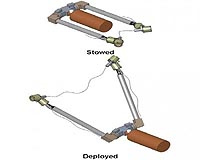 |
Tucson AZ (SPX) Jul 09, 2009 Planetary scientists have monitored some Martian sand dunes for more than 30 years, and the dunes have not moved during that time, leading scientists to question whether snow and ice trapped inside the dunes might be preventing movement. However a recent study published in "Geomorphology" shows that snow and ice are not enough in themselves to stop dune movement. While trapped ice and snow impedes movement of sand dunes in polar climates, compared to their counterparts in warmer areas, this does not entirely stop dune movement, the study shows. This indicates that other factors are limiting dune movement, said Mary Bourke, a senior research scientist at the Tucson-based Planetary Science Institute. Bourke led the study, which covers the longest time period of any cold-climate dune migration and dune dynamics study to date. In a paper published last year, Bourke also showed that two small dunes recently disappeared on Mars. The dunes, which were 20 meters wide (about 65 feet) and located in the north polar region of Mars, were completely eroded away over a period of 5.7 Earth years. "This (dune disappearance) is fantastic new data, showing that sand is transported on Mars where and when the wind energy is available," Bourke said. "But the bigger, larger dunes on Mars are not moving, at least in the areas we studied." In the most recent study, Bourke and her colleagues used vertical aerial photos and LiDAR (Light Detection and Ranging) data to estimate dune migration rates in Antarctica's Victoria Valley dune field. The photos, taken between 1961 and 2001, came from the USGS Antarctic Resource Center. These dunes are known to be covered by seasonal snowfalls and have snow and ice layers trapped inside. Bourke found that the dunes migrated about 1.5 meters (5 feet) per year, which is small compared to the distance covered by dunes in warm deserts, which can be as high as 30-70 meters (about 100 to 230 feet) a year. Recent images from the HiRISE camera that is orbiting Mars reveal crusted surfaces on the dunes scientists have monitored since the first Viking mission in 1975. These appear to be similar to hard-surfaced sandy deposits found in some of Earth's deserts. The dunes also have cemented layers. These could be cemented by ice or by geochemical processes. Other factors limiting dune movement on Mars would include the planet's thin atmosphere, which requires very high wind speeds to provide the force needed to move sand, and the water and carbon-dioxide frosts that cover dunes in Mars' polar regions for 70 percent of the year, Bourke said. But, Bourke adds, the study of dune movement in Antarctica's Victoria Valley shows that dunes in the cold weather environments found on Mars, Titan and other frozen bodies still have the potential to move, organize and evolved in the same way that dune fields do on Earth. NASA's Mars Fundamental Research Program is funding this research under a grant entitled "Volatile-Rich Aeolian Deposits: A Field-Based Analogue Study". Those who worked with Bourke on the research include: Ryan C. Ewing, of the University of Texas at Austin; David Finnegan, of the U.S. Army Cold Regions Research and Engineering Laboratory; and Hamish A. McGowan, of the University of Queensland in Australia. Share This Article With Planet Earth
Related Links Planetary Science Institute Mars News and Information at MarsDaily.com Lunar Dreams and more
 New Instrument Could Detect Water Deep Underground On Mars
New Instrument Could Detect Water Deep Underground On MarsSan Antonio TX (SPX) Jun 25, 2009 With the whoosh of compressed gas and the whir of unspooling wire, a team of Boulder scientists and engineers tested a new instrument prototype that might be used to detect groundwater deep inside Mars. The Mars Time Domain Electromagnetic Sounder (MTDEM) uses induction to generate electrical currents in the ground, whose secondary magnetic fields are in turn detected at the planetary ... read more |
|
| The content herein, unless otherwise known to be public domain, are Copyright 1995-2009 - SpaceDaily. AFP and UPI Wire Stories are copyright Agence France-Presse and United Press International. ESA Portal Reports are copyright European Space Agency. All NASA sourced material is public domain. Additional copyrights may apply in whole or part to other bona fide parties. Advertising does not imply endorsement,agreement or approval of any opinions, statements or information provided by SpaceDaily on any Web page published or hosted by SpaceDaily. Privacy Statement |